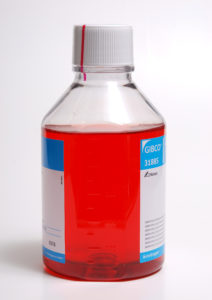
Cell culture media preparation: Significant impact on cell growth
The type of media used determines the success of mammalian cell culture. Most mammalian cells require specialized media supplemented with a complex mixture of nutrients, sugars, amino acids, vitamins, minerals, and growth factors such as insulin. The media provides energy for cell growth and other compounds that are essential to regulate cellular processes.
The type of culture media used is determined by 3 main factors. 1) The type of cell (mammalian or bacterial) used, 2) the purpose of cell culture, and finally 3) the seeding density requirements.
Culture media preparation, storage and use
There is a wide range of media available, customized for different types of cells and their metabolic requirements. These remain consistent for both 2D monolayer cultures and 3D cell cultures with and without the addition of scaffolds. Most commercially available media are provided as a dehydrated or powder form (for prokaryotic cultures), liquid concentrate or as working solutions for cell lines.
– Dehydrated media- dissolved in distilled water using aseptic techniques, pH adjusted, and sterilized prior to use.
– Powdered media- dissolved in distilled water, stirred, sterilized and then poured in to sterile petri dishes using aseptic techniques (e.g. LB broth, usually used for bacterial cultures)
– Liquid concentrates are usually diluted in distilled water using aseptic techniques, adjusted for pH and stored in sterile containers for further use.
– Culture media prepared as working solutions are obtained ready to use, following the addition of additions serum or supplements (e.g. antibiotics) under sterile filtration, and aseptic conditions, and then pre-warmed to 370C prior to addition to cells.

Culture media is usually sterilized via filtration, boiling or autoclaving. Ready use, working media solutions are usually sold as sterile, although sterile filtration and aseptic techniques are recommended when handling. In all cases, aseptic techniques are used to avoid cross contamination, and growth of unwanted microorganisms.
Serum can be added to cell culture media to facilitate the growth of certain cell lines. Fetal bovine serum (FBS) is among the most common serum added to cell cultures. Hormones and other growth factors can also be added to help the growth of specific types of cells. Additionally, additives such as IPTG can be added to encourage expression of proteins. Furthermore antibiotics are routinely added to inhibit the growth of bacteria and fungi.
Once prepared cell culture media, in liquid form or as agar are stored at 4oC in the dark, to avoid growth of opportunistic organisms and light degradation of media components. When in use, the media is pre-warmed to 370C prior to addition of cells.
The most commonly used cell culture media for mammalian cells includes; MEM (minimum essential medium (applicable for most mammalian cells), DMEM (modified MEM), RPMI 1640 (traditionally used to grow human lymphocytes, bone marrow cells), Ham’s f-12 (growth media for mammalian cells), IMDM (modified version of DMEM) Leibovitz L-15 (Supplemented with L-glutamine), and DMEM/F-12 (DMEM with nutrient mixture F-12, used as a basal media for mammalian cells such as glial cells, fibroblasts and human endothelial cells).



